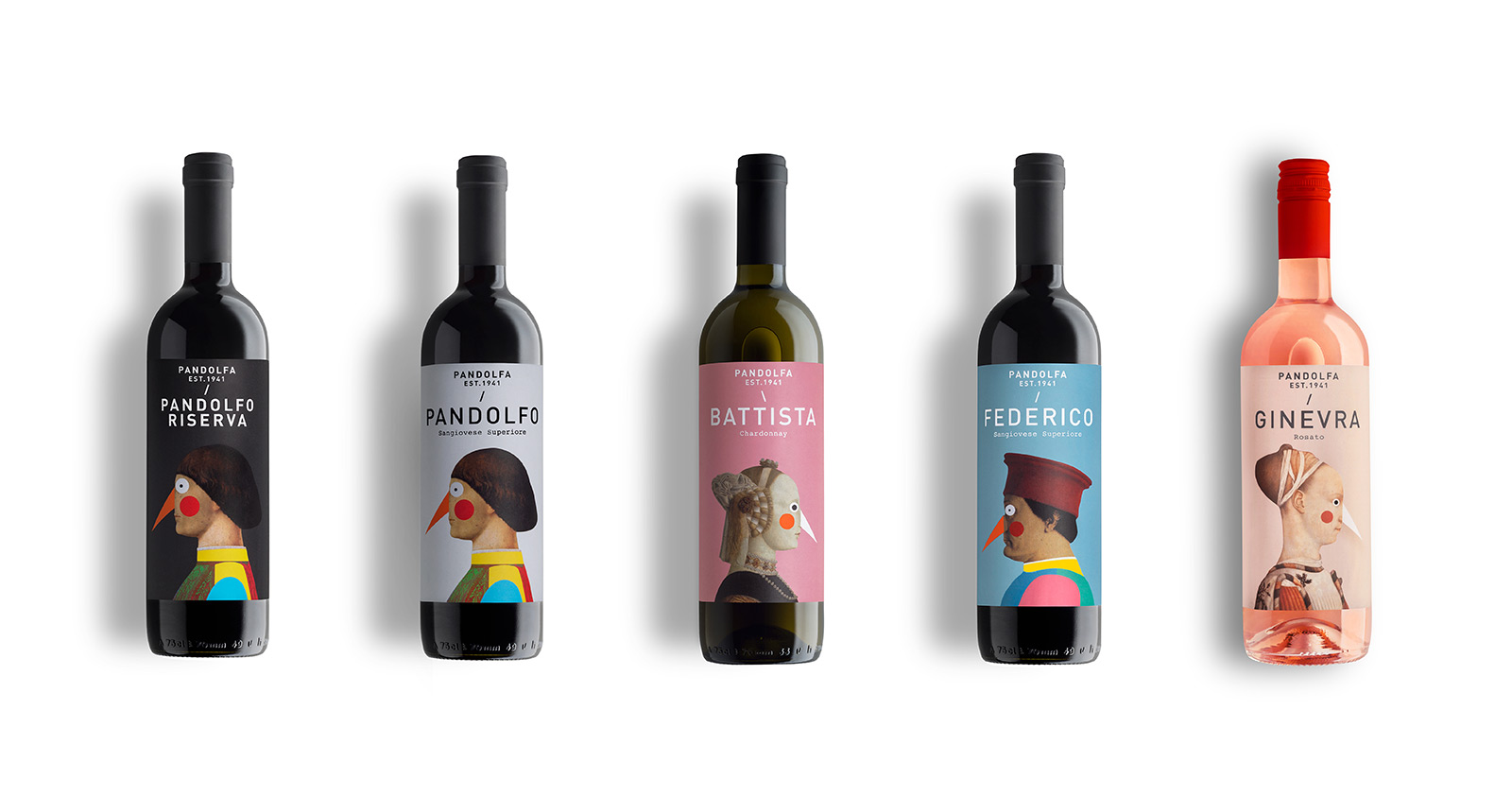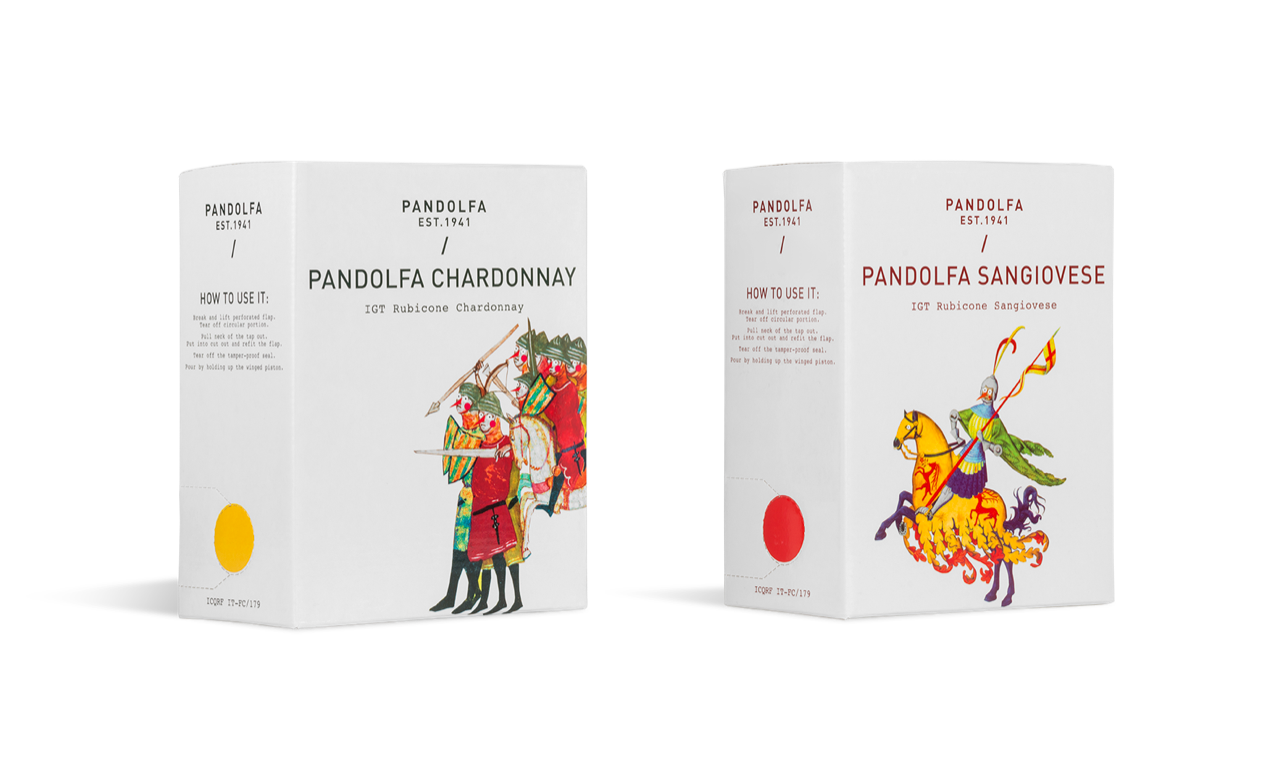Identity
Pandolfa is getting ready to experience a second Renaissance, which begins with wine. The estate’s past and present come together in its bottles of wine.
The Renaissance figures closely associated with the estate’s history come back to life on our bottle labels, one above all: Sigismondo Pandolfo Malatesta as depicted by Piero della Francesca. In an ironic and contemporary language, Pandolfo Malatesta, his first wife Ginevra, Federico da Montefeltro (his bitter enemy) and wife Battista Sforza appear amidst colors inspired by the fifties, the years when the Villa underwent major restoration works, and with bird-like beaks in place of the nose, as a tribute to the work of art Calamita Cosmica by Gino De Dominicis and, in general, to Italian art.
Our goal is immediate recognizability: on one side, that of figures and works of the past, on the other, our wines ‘straightforward character.
We also aim to highlight the uniqueness of our history and the way we are still writing it day by day: with enthusiasm, commitment and a touch of light-heartedness.
We know where we come from and where we want to go.
Climate Trend 2018
The weather pattern of 2007 continued into 2018, with high temperatures and moderate rainfall. In early February, the natural vegetation, as well as fruit-bearing plants, were ready to start their growth cycle again with the blooming of violets and calendulas and the blossoming of cherry and apricot trees in the sunniest fields.
Winter arrived in mid-February with abundant rainfall and snowfall even at a low altitude. There was much concern over the minimum temperatures dropping below -8°C degrees and, in some cases, below- 12°C in many areas of Central Italy. Such an unusual drop in temperatures at this time of the year damaged olive groves and orchards and slowed down the growth of cover crops, but caused only sporadic damage to the vines.
The months of March, April and May saw heavy rainfall which, in addition to the winter snowfall, contributed to the replenishing of the aquifers and rivers that had been heavily depleted throughout 2017. Mild spring temperatures and no heatwaves, but long periods of heavy humidity (it had not been so intense in May for years).
The vines then reached the flowering stage and vegetative vigour, but there was some concern about downy mildew, grape shatter and powdery mildew affecting the vines because of the meteorological conditions (rainfall and humidity) and because of the difficulty in performing phytosanitary treatments and canopy management operations at the right time.
A good average yield (especially where, in 2007, the production was low because of the frost), with the exception of the vineyards seriously stressed by the 2017 summer drought (which occurred at the same time as the forming of fruit buds).
The summer got off to a cool start, with frequent rainfall and moderate maximum temperatures. Over the last ten days of July and the first twenty days of August, the arrival of African anticyclones over Italy led to a sharp rise in temperatures alternating with violent downpours and, unfortunately, hailstorms as well.
The vines, which reached the summer season about ten days behind the average ten-year-period schedule, coped with the heat stress differently, either draining the soil’s water supply and making up for the delay or showing signs of stress and loss of foliage, in particular, the younger vines or those most exposed to the sun and south-east wind.
Fall arrived soon, in early September, providing wonderful night-day temperatures swings and some concern, as a sudden rise in temperatures in mid-September, accompanied by rainfall, promoted the proliferation of Botrytis cinerea and bacteria.
Harvest time arrived at last, and not ahead of schedule, often with higher grape yield than expected due to the berries’ high growth rate and some apprehension about the grapes’ phytosanitary state and risk of grape dilution. The well-balanced vines got the best out of the season’s slow ripening process and impressive temperature swings, with the minimum temperatures dropping well below 8° C in late September.
The vintage can be described as interesting: not too concentrated or excessively green, rich in fruity aromas, relaxed tannins and salty on the palate, at times ambitious enough to compete with the fresh yet very elegant 2010 vintage.
![]()





